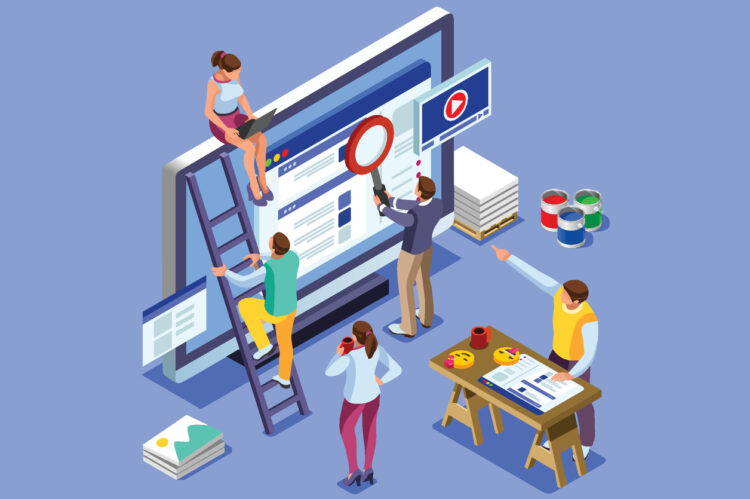The biggest advantage of outsourcing is the ability to hire an expert for a fixed period of time without being tied to him in the long run. Even if the hourly rate or cost of a project is higher than hiring workers, you can save thousands on wages and levies.
When one hires an outside web agency to run the business or part of the business, it is called outsourcing.
The most common reason for outsourcing is the efficiency and the cost. Outsourcing is not only useful in reducing costs and saving money but also makes individual tasks faster and more efficient, allows market penetration faster than the competition, maximizes workforce flexibility, and provides access to highly skilled workers. This makes it one of the most significant business trends of today.
But what are the ways to successfully outsource web design projects? Read the rest of the article.
Page Contents
1. Create clarity about what you expect

Source: designrush.com
This may seem too obvious and wide, but any successful project always begins with a clear statement of what you are hoping to achieve. Define your project requirements ahead. Service providers need accurate, complete information to present you with realistic proposals and calculate a reasonable price. Be specific about the results you expect from the services given.
Give as much information as you can about what you need to deliver and the way you need the job to be done. Also, be clear and realistic about your scheduling requirements – project plans and timetable can have a big impact on project costs.
2. Clear and understandable dialogue
Prior to launching any project and knowing what you want, having a clear dialogue about it will ensure what is expected, is achieved. There is no universal web design pattern that suits everyone. Based on the vision, there are various organizations specialized in what has been envisioned.
Successfulness highly depends on the clarity of vision and communication. Depending on the complexity of expectations and the task, different outsourcing companies can be selected to answer their needs. Therefore, we get to the next point.
3. Select a suitable company

Source: nordwhale.com
Ideally, the company you choose will have to have a specific experience with the type of project you are undertaking. You don’t want to be someone’s “guinea pig”. When it comes to web design and the services that might be expected to be carried out fc-networks.com is a good example.
This is especially crucial when issuing complex technical projects such as web design or software development. For example, if you’re looking for someone to develop an iPhone app, make sure they’ve actually completed commercial projects on that platform for other satisfied customers. This advice also applies to other types of projects. If you need a business plan to open a retail store, you will get the best results if the consultant you hire has proven experience in the retail sector.
4. Ask the right questions
Being sure your selection is right, requires asking some additional questions, and one should never be afraid to ask them. It just likes hiring a full-time employee, choosing a company is a very subjective experience. Check their references and ask for feedback from other clients who have used their services. Get involved in the dialogue – if you have any concerns about the specific capabilities, voice your concerns. Don’t just push around and hope for the best.
While it may be tempting, never choose based solely on price. Experienced organizations who have hired many project vendors and evaluated hundreds of proposals, almost always recommend rejecting the most expensive offer and the lowest price.
Buyers report that their most successful projects are those where they felt the seller offered a balance of good value and quality results. For a successful web design outsourcing, always keep this in mind.
5. Negotiate a warranty

Source: inc.com
For projects related to web design, it is a good idea to specify a warranty or support period so that you are sure you’ll get enough support from the vendor to be able to use everything after they have completed the project. It is much easier or smarter to negotiate a support period before the work starts, and not after the project is completed. Even creative or business services can benefit from a support clause. Suppose you need some changes to your website based on the feedback you receive from potential customers. Or you may know that you need that powerful new logo that comes in a new file format. Determining a certain amount of free support or negotiating discounted prices for future modifications can save you time, money, and headaches later.
6. Have everything in written
Most of the time making a deal as a result of the negotiation is not enough. That’s what contracts are for.
A lot of things can develop in different directions than what was planned. The scope of work can change, delivery deadline, or even a price. That’s why it is crucial to make everything in written form. As well as to have a clear written proof of all the changes that occurred, so each side of those involved in the web design project is aware of the course of action.
Similarly, keep a record of any changes to the agreement that you request from your service provider and accept or reject those changes. Save copies of all email exchanges you have.
Nowadays, literally, anything can be outsourced, therefore the word “successful” is even more important. Because of this many different people offer their services, as freelancers, which can have its advantages or disadvantages. The obvious advantage of choosing a company is the team of people that will be involved in all the work, compared to hiring a single individual. Whatever the choice for web design outsourcing may be, choosing an organization or an individual, what was stated in this article can be of help.





